Air Cleaning Technologies to Mitigate Your Building’s Infection Risk

As building owners address reopening strategies during the COVID-19 pandemic, there seems to be but one question on everyone’s mind: How do I ensure my building is safe? Because the virus is largely transmitted through airborne respiratory droplets, taking measures to improve air quality can potentially reduce the spread of disease in many facilities.
It’s important to note that health screening and enforcing mask-wearing are critical first steps for stopping the spread of infection at its source. However, there are a wide range of air cleaning technologies and approaches that serve as a critical secondary layer of protection. These solutions can aid in the process of improving the air inside an occupied space to reduce the risk of the spread of infection.
Identify The Right Solution
Selecting the right solution depends upon a number of factors, but there’s one consistent place to begin. Any air cleaning strategy must begin with a review of the guidelines from applicable agencies, including the CDC, ASHRAE, and industry-specific organizations.
Next, it’s important to understand the constraints that may be presented by your existing equipment. As a case in point, mechanical filtration is typically the first line of defense against airborne pathogens. Filtration media should already be present in your system. However, the efficiency of these filters ranges dramatically—and your system may not support the filtration level necessary to reduce the spread of pathogens.
ASHRAE advises using filters that are MERV 13-rated at a minimum, because these filters are more efficient at capturing airborne particles of a smaller size (less than 0.3 microns) than lower efficiency filters. The challenge is that more efficient filters often lead to an increased drop in pressure at the filter. Your existing HVAC unit may or may not be capable of overcoming the greater pressure drop of a higher efficiency filter. An experienced mechanical engineer can advise you as to whether your system is able to support the recommended filtration, or if a portable air filter may be a more effective choice.
It’s also important to remember that mechanical filters are limited in their ability to remove the smallest viral particles. That’s why filtration is an excellent starting place for a more layered approach.
Balance Efficiency with Comfort and Cost
The next step in a layered approach is often an increase in outdoor air ventilation. Increasing the ventilation rates beyond minimum code-required levels can improve the overall indoor air quality, but can also lead to some unintended consequences. Most notably, your existing HVAC system may not be able to maintain the expected levels of comfort in terms of temperature and relative humidity.
What’s more, as many parts of the nation brace for the coming of cooler temperatures, they’ll find winter’s lower humidity levels promote increased airborne transmission of all kinds of viruses. Low humidity also weakens the body’s ability to fight off pathogens, just as those pathogens’ airborne transmission rates rise.
Solutions to this challenge can range from simply adding a countertop humidifier to installing a whole-system energy recovery ventilator (ERV) and central humidifier. An ERV can permit the required higher ventilation rate while still maintaining acceptable comfort levels. These systems also help reduce energy usage and the resulting costs, yet another impact to consider with any chosen solution.
Investigate Other Air Cleaning Technologies
An additional layer of air cleaning many facilities managers and owners may consider are solutions that use ultraviolet light or ionization to disinfect the airstream or an entire space. There are a wide range of available solutions, each with varying levels of scientific evidence backing them.
While some solutions, such as germicidal UV-C lamps, have a long history in medical facilities and have proven very effective at eliminating biological hazards, others have less scientific backing behind them. Before investing in any solution, it’s important to ensure it has been independently tested by a recognized agency. In the case of ionization systems, for example, independent testing should confirm it does not give off dangerous levels of ozone or other toxins as a byproduct of its operation.
Sort Through The Misinformation
With so many customers seeking air cleaning solutions, there’s a lot of misinformation out there. Some of the technologies you’re likely to come across have been time-tested in tightly regulated medical and biotech facilities. Some are promising new technologies that may or may not prove to be effective in the long run. Other technologies have already been proven to be ineffective in controlling infection agents or, worse, generate other health hazards as byproducts.
While a layered approach will prove to be most effective in reducing infection risks, building the right layers will largely depend on the type of HVAC system you currently have in place and the intended use of your building. For many building owners, the right solution may require a significant upgrade of the existing system—an upgrade that could mean all the difference in securing trust from your tenants or customer base.
To learn more about the options available today, download our series of white papers, Enhanced HVAC Infection Control.
If you’re ready to move to the next step, don’t hesitate to reach out. Schnackel Engineers is available to assist with your reopening plans or facility upgrades.
Comments